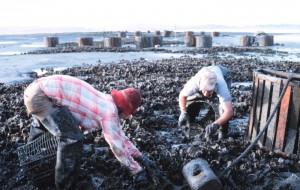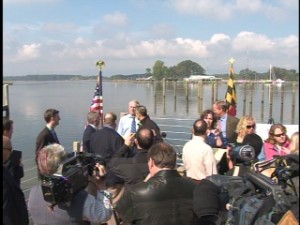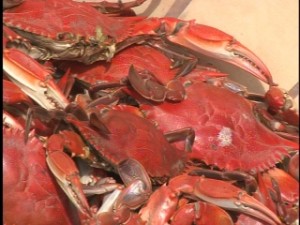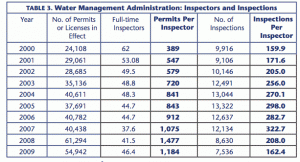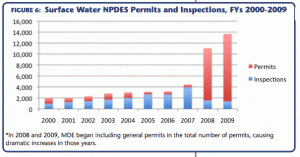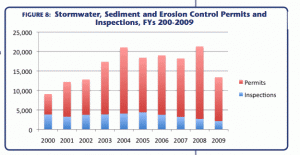21
Is Environmentalism Useful?
Environmentalism is dead. Liberal politics is out of touch. Those thoughts are the basis for the book “Break Through” written by two Oakland, California-based climate and energy strategists, Ted Norhaus and Michael Shellenberger.
Although the book came out three years ago, the arguments it presents are still worth examining — that environmentalists need to move on from single-issue, special interest, complaint-based arguments towards developing in tandem with the business world a whole new kind of economic development.
Regulations alone, the authors argue, will not change pollution and global warming problems – such as those affecting the Chesapeake Bay, which is important to the regional economy in its watershed. What is needed for creation of a new, clean-energy economy is major public investment in solar, wind, hydrogen and bio-fuel technology.
Norhaus and Shellenberger emphasize that what is missing in the United States is politics focused on “possibility, investment and innovation, not limits, pollution and regulation.”
This is an interesting approach, particularly given the perspective of such other respected authors as Howard Ernst, who states that the only way polluters will change is through the creation and enforcement of pro-environment laws.
After millions of dollars have been spent on cleaning up America’s rivers and estuaries with relatively little success, and after laws and regulations get watered down and ignored, it might be worth taking another look at “Break Through.”
Note: Ted Norhaus and Michael Shellenberger run the Breakthrough Institute in California. Howard Ernst is a political science professor at the U.S. Naval Academy and author of “Fight For The Bay.”
21
Opening Day Exciting for Rockfish Enthusiasts
“It’s just that whole thing is amazing, the excitement. The ramps are always packed… ,” Annapolis resident Mike Billings said in an interview with Hometown Glen Burnie. “It literally is electric.”
After a snowy winter, the welcome sunshine and relaxing day of fishing are a sight for sore eyes for the recreational sport fisherman who enjoy this special day. read more
20
MPT Presents Chesapeake Bay Week, Volunteer-a-thon
Maryland Public Television is focusing on the Chesapeake this week, just in time for the environmental protection festivities of Earth Day. MPT is running shows about the lives, perils and history of the Chesapeake Bay, including older documentaries and new programs like Chesapeake Bay by Air –an aerial perspective of wildlife on the bay.
As a capstone to the week, MPT will be hosting a Volunteer-a-thon co-sponsored by Bank of America on April 25, where viewers can pledge volunteer hours to helping restore the Chesapeake. Last year, more than 13,717 hours were pledged during the Volunteer-a-thon, with viewers pledging to clean the bay from more than 70 organizations.
Additionally, MPT has a list of organizations within the watershed where people can volunteer. MPT has the programming schedule online and additional resources at the Chesapeake Bay Week website.
16
Oyster Farming Talk Gaining Momentum in Chesapeake Bay
More than 90 percent of oysters landed around the world are the result of some sort of oyster farming, according to marine scientists. But that is not the case in Maryland , where aquaculture never really caught on despite a dramatic decline in the oyster population.
That could change soon. State officials are promoting some new oyster farming proposals, ideas which could gain popularity in the wake of recent good news about Maryland’s blue crab. On April 14, Gov. Martin O’Malley announced that blue crabs are on the rise, thanks to harvest restrictions that helped boost the adult female crab population.
Now the Maryland Department of Natural Resources aims to help spark a similar revival in the oyster population, through a proposal it calls the Oyster Restoration and Aquaculture Development Plan. Released in December 2009, the plans calls for expanding the number of no-harvest zones that would be off limits to oystering, and increasing the areas available for leasing to private oyster farming operations in the Chesapeake Bay.
If the plan to encourage oyster farming is successful, it would bring Maryland’s oyster management “efforts more in line with virtually all other regions in the world,” according to University of Maryland marine biologists Victor Kennedy and Roger Newell.
In a recent article, Kenney and Newell noted that the problem dwindling oysters has been the subject of political discussion for three centuries:
“In 1701, a Swiss visitor reported that Chesapeake oysters were so abundant that ships sometimes ran aground on oyster reefs, and so large that they had to be cut in two to be eaten. Over time, Maryland’s oyster industry grew until the landings in the 1880s were twice those of the rest of the world combined. However, about that time annual harvests began to decline, causing much consternation.
An Oyster Commission formed in 1882 to study the problem linked the harvest decline to overfishing, diminishing amounts of settlement material (shell) and destruction of oyster spat by harvest practices. Among other recommendations, the commission called for a reliance on trained experts — not politicians — to close oyster beds where and when necessary to allow for rehabilitation. It also recommended a system of private oyster farming on bottoms leased from the state to supplement the public fishery.
Unfortunately, there was no political will to implement these two conservation measures. These recommendations (and similar recommendations by a number of later commissions) were not followed, and more than a century later this same debate is again taking place in Annapolis.”
Maryland already runs a volunteer program that encourages individuals to grow baby oysters and deposit them in the bay, for which it maintains a “guide to growing oysters” page on a state government Web site. But the move into commercial aquaculture represents a bigger shift and likely will take more than individual initiative from citizens.
Maryland politicians have reached no consensus yet on what kind of oyster farming would be best for reviving the Chesapeake bivalve. But since it is an election year, with the governorship and all 188 seats in the General Assembly at stake, the debate should be interesting to watch.
16
Oyster Sanctuary Plan Irks Watermen
In an effort to decrease the number of “dead zones” in the Chesapeake Bay, some Maryland legislators support the call for more oyster sanctuaries issued by Gov. Martin O’Malley and the state’s Department of Natural Resources.
But this has been met with fierce opposition from watermen, who contend the sanctuaries could put many of them out of business.
Proponents believe sanctuaries can help revive the bay’s oyster population and clean the bay–and that a healthy Chesapeake should take priority over the livelihood of watermen.
“Hunter-gatherers in society are being squeezed out all over the world,” Sen. Brian Frosh (D-Montgomery) testified at the House Environmental Matters Committee during the legislative session that concluded this week. “This is not one of the industries of the future.”
But many watermen believe pollution is the main cause of lowered oyster counts in the bay, not watermen and their fishing. Watermen lobbied in the Maryland General Assembly this year to delay or defeat the plan to create additional oyster sanctuaries.
To help revive the bivalves, Gov. O’Malley has been promoting a plan to expand the number of oyster reefs in the bay deemed “no harvesting” zones. Opponents pushed a proposal to delay creation of these sanctuaries for a year or more, but their measure died when legislators adjourned this week, according to the Bay Daily blog.
Other plans are afoot to boost the oyster population through aquaculture. On April 3, the Maryland Department of Natural Resources submitted a proposal for federal stimulus funds in the amount of $10 million to fund oyster-related projects. In that proposal, DNR recommended the infusion of ariakensis (Asian oysters) into the bay.
But on April 6, that proposal was criticized as ecologically risky by the U.S. Army Corps of Engineers, which recommended a native-only oyster restoration plan instead. The native-only plan drew praise from the governors of Maryland and Virginia.
While reducting algae blooms in the bay has long been a priority for bay preservationists, environmental agencies also have been trying to figure out a plan to replenish oysters, which act as a natural filter to clean the water. The decline in the Chesapeake’s oysters has been steep, with 80 percent of oyster bars disappearing from Maryland’s waters over the past 25 years, according to U.S. Rep. Frank Kratovil.
15
Blue Crab Population Up 60 Percent
Watermen and scientists spent the winter months counting the blue crabs in the Chesapeake Bay and have finally released their findings. The Maryland Department of Natural Resources annual winter crab dredge survey report determined that the crab population has increased 60 percent in the last year. There are now 658 million crabs in the bay. This is the highest crab count since 1997.
Maryland Governor Martin O’Malley announced the news on April 14 at the Fisherman’s Inn Crab Deck on Kent Narrows, where he proclaimed it a great day because “The Chesapeake Bay’s blue crab population is actually roaring back, and actually coming back stronger than many would ever have predicted.” O’Malley was joined by many other officials, including DNR Secretary John Griffin and Chesapeake Bay Foundation President Will Baker.
The best news of the day, according to Lynn Fegley of DNR’s Fisheries Service, was the increase in the adult crabs because they spawn and produce the next generation of crabs. Fegley said it was the highest the adult crabs have been since the early 90′s.
Even with the apparent turnaround in the crab population, officials are unlikely to lift the current restrictions on crabbing. At the press conference, Griffin said, “Two years does not necessarily make a trend.” He went on to say he wants to “avoid some of the boom and the bust from the past– 1993 and 1997, where we had a spike up in abundance and then a quick drop off.”
But many who work in the industry, including Jack Brooks, President of the Chesapeake Bay Seafood Association and co-owner of a crabmeat processing plant in Cambridge, want more freedom to catch. Brooks said the higher population is good news and hopes it “will enable an easing up on some of those restrictions to enable the folks to get back and benefit from their sacrifices.”
April 1 marked the start of crabbing season in the Chesapeake Bay, and it will be interesting to see how the harvest season turns out this year.
The owner of Fisherman’s Inn, Sonny Stulz, said he is optimistic for Maryland’s blue crabs. “We have to deal a lot with Louisiana and Texas to get our crabs” Stulz said, “so to get them locally would be great.”
CBF applauded the efforts made by Maryland and Virginia to bring back the crabs and said that the work must continue. “This is not the end of the problem of threatened Bay species and a struggling Bay seafood industry,” Baker said, “but it is a sign that managed the right way, the fisheries can respond and even flourish again.”
15
MD Water Enforcement Falls Short, Report Says
The Maryland Department of the Environment is “drastically underfunded” and lacks the resources needed to enforce water pollution laws, according to a report released this week.
The report, “Failing the Bay: Clean Water Act Enforcement in Maryland Falling Short, ” was commissioned by the Abell Foundation of Baltimore and the Center for Progressive Reform.
The study found that MDE’s budget for Water Management Administration (WMA) declined from $3.39 million to $3.16 million between 2000 and 2009. During the same period, the number of inspectors in Maryland’s water management program declined even more sharply: There were 25 percent fewer active, full-time inspectors in 2009, the report found.
The report criticized WMA’s enforcement program for not effectively deterring dischargers from violating federal and state water quality laws. “MDE’s enforcement efforts are squeezed to the edge of ineffectiveness by an increasingly tight budget and a poorly designed program that fails to maximize its deterrent impact,” the authors concluded.
While Maryland has tough environmental laws, MDE lacks sufficient funding for enforcement and does not currently have an adequate enforcement program to achieve the goals set under the federal Clean Water Act and its own state laws, according to the report’s findings.
The problems are especially pronounced in permit enforcement, the report said. As illustrated by the graph above, MDE has relatively few inspectors for the large number of permits and licenses that need inspection.
Above is another graph from the report, showing how many of the surface water permit sites governed by the NPDES ( National Pollution Discharge Elimination System) and under control of the MDE actually get inspected. In 2008 and 2009,less than one-fourth of the surface-water permit sites actually were inspected.
According the report, inspection rates for stormwater, sediment and erosion control permits were no better. The report’s graph is below.
15
Permission to Pollute ‘Administratively Continued’ in Some Chesapeake Bay States
Some states in the Chesapeake Bay watershed are falling behind in reviewing permits designed to curb stormwater pollution, according to Environmental Protection Agency reports.
Stormwater is the fastest growing source of pollution in the Chesapeake Bay. It is a serious problem because so much soft ground with plant cover that once absorbed and filtered pollution out of rainwater has been covered by hard surfaces such as roads, roofs and parking lots. These impervious surfaces prevent rainwater from being absorbed into the ground. Instead, it runs into the streams and rivers that feed the Chesapeake Bay.
In order to control the environmental impact of stormwater, the Environmental Protection Agency set up a permitting program to regulate stormwater runoff called the National Pollutant Discharge Elimination System (NPDES). Permits issued under this program control facilities whose discharges go directly into lakes, rivers and streams from identifiable agricultural, domestic or industrial sources. For example, runoff from municipal sewage treatment facilities and construction sites are both regulated by NPDES permits.
Many states in the Chesapeake Bay Watershed are behind in updating the permits that control what kind of discharges and how much of them a facility or company can allow to run off a work site and into waterways.
After the state issues a NPDES permit, it is good for five years. At the end of that five-year period, (180 days before its permit expires) a facility must apply to have its permit renewed. When a complete application for renewal is received, but not officially re-issued by a permitting authority, it becomes “administratively continued.” Put simply, the permit becomes backlogged (this can also include facilities waiting for their first NPDES permit).
The EPA measures how effectively states keep up with backlogged permits by tracking their “percent current rates,” which is the number of facilities with current permits divided by the total number of facilities.
Facilities in the Chesapeake Bay watershed that release one million gallons of runoff per day, individual major permit holders, and those that do not produce as much runoff, individual minor permit holders, both have 90 percent current goals.
Virginia has the highest percent current rates in the bay watershed. Its rate for major permits is 99.3% and 98.3% for minor permit holders. EPA reports indicate that West Virginia has the lowest percent current rate for minor permit holders, at 56.3%. It show s that Delaware, at 65%, and Maryland, at 69.5%, have the lowest percent current rates for major permit holders in the Chesapeake Bay watershed.
Overall, none of the percent current rates fall below 50% for states in the Chesapeake Bay Watershed. Most percent current rates for both major and minor permit holders are between 70 and 90%, leaving an estimated 20-30% that are backlogged or “administratively continued.”
13
Earth Day Shifts Focus To Water
Earth Day is coming up on April 22. And in Maryland, many residents are shifting their focus from the earth to the water – the water of the Chesapeake Bay, that is.
The bay’s pollution is sparking people into action on a day when protecting the environment is the main focus.
Earth Day events in the Annapolis area are a tradition. There are festivals, a foot race and even a happy hour. But these activities are not just fun and games.
Jim Brennan, coordinator for the 7th annual Earth Day festival, told the Annapolis Capital the festival is about, “education and action – the ways we can improve the local waterways and the local environment.” read more
11
D.C.’s ‘Forgotten River’ To Enter New Stage of Restoration
The Anacostia River runs all of 8.4 miles from stem to tip.
Those 8.4 miles of water are among the dirtiest in the nation, yet flow mere miles from the U.S. Capitol Building.
Thanks to heavy runoff from the Washington Navy Yard, antiquated and aging sewer systems in the Near Southeast neighborhood of Washington and heavy amounts of raw sewage, the Anacostia is by far one of the most polluted bodies of water in the Chesapeake Bay watershed.
And, while D.C.’s other river, the Potomac, continues to see major and continued cleanup and maintenance efforts, the Anacostia has sat for years collecting trash and toxic pathogens. Though revitalization of the Anacostia’s waterfront neighborhoods has progressed, the river itself continues to languish.
Now, though, the mobilization begins.
On Monday, the Anacostia Watershed Restoration Partnership, along with several local politicians, will unveil a new restoration plan for those 8.4 miles of river that snake through the east side of Washington.
Release of the plan comes in the wake of a Department of the Environment study showing that plastic shopping bags made up 21 percent of the trash in the Anacostia, a study that prompted the city to enact a five-cent bag tax to raise funds for cleanup efforts.
Over the next few weeks and into the summer, I’ll be taking a look at what activists, politicians and others are doing to restore these 8.4 miles of river. I’ll also be looking at efforts to revitalize the Southwest Waterfront area of D.C. as a bustling business and residential district , to see how that revitalization might affect efforts to clean up the Anacostia.







